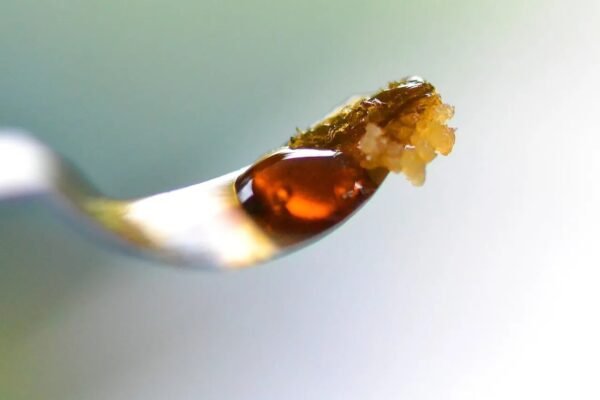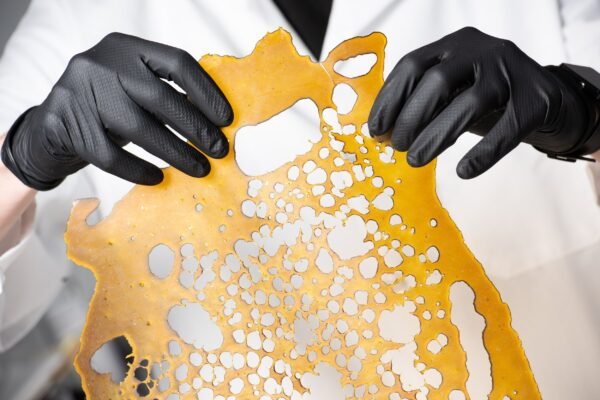Dabbing looks simple—drop, sizzle, inhale—but the choices behind that tiny drop can feel like a maze. In the next few minutes, I’ll clear the smoke and make those choices easy.
The best dab for you depends on what you value most: flavor (live resin, rosin), potency (THCa diamonds, crystalline), ease-of-use (crumble, sugar), or solvent-free appeal (hand-pressed rosin). Match the concentrate’s texture to your device, keep temperatures low to protect terpenes, and always buy lab-tested products for safety.
Picking concentrates shouldn’t feel like homework—let’s break things down one question at a time.
1. What Are the Different Types of Dabs Available?
Wax, shatter, crumble, budder, live resin, sauce, diamonds—the list keeps growing, and each one behaves a little differently on a nail.
Most dispensaries sort concentrates by texture: brittle shatter, creamy budder, grainy crumble, syrupy sauce, terp-rich live resin, glass-like diamonds, and solvent-free rosin. These labels tell you how the extract handles heat and how strong the aroma might be.

Handling & Heat
Different textures melt at different rates. Shatter snaps into neat shards—great for cold-start dabs—while budder whips into a spoon-friendly paste ideal for precise dosing.
Terpene Retention
Live resin preserves plant terpenes by freezing fresh flowers before extraction, giving you brighter aromas than room-temperature BHO runs. For purists chasing scent, start here.
Potency Spectrum
THCa diamonds regularly hit 95 %+ cannabinoids, while most waxes hover around 70 %. More potency isn’t always “better”—it just means smaller servings.
| Texture | Typical THC % | Terpene Level | Handling Tip |
|---|---|---|---|
| Shatter | 70-80 % | Medium | Snap tiny shards with a dab tool |
| Crumble | 65-80 % | Medium | Scoop and press gently |
| Live Resin | 70-85 % | High | Keep jar cold to slow sugaring |
| Rosin | 65-80 % | High-Very High | Store in parchment, avoid light |
| Diamonds | 90-99 % | Low | Blend with sauce to balance flavor |
2. Which Dab Type Offers the Best Flavor Experience?
Flavor lives in terpenes, and terpenes hate heat and solvents. That narrows the field fast.
For pure taste, choose live resin or cold-cured rosin. Both preserve fragile aroma molecules lost in hotter, solvent-heavy processes. Keep dab temps between 480 °F – 540 °F for maximum terp pop.
Why Live Matters
Freezing buds within minutes of harvest locks in plant volatiles. When those volatiles evaporate on a low-temp nail, you get the citrus zing or pine snap the breeder intended. Learn more from Leafly’s live resin guide
Rosin’s Solvent-Free Edge
Rosin presses flowers or bubble hash with only heat and pressure, no hydrocarbons. The result is creamy and loud—think fresh-squeezed juice versus canned.
Temp Control Tricks
Use an infrared thermometer or an e-rig preset to 500 °F. Going hotter shrivels terps; cooler may puddle oil. DabConnection explains the science behind low-temp pulls.
3. What’s the Strongest Dab for a More Intense High?
Sometimes you want fireworks, not candles.
If raw power tops your list, hunt for THCa crystalline or diamonds soaked in terp sauce. Labs clock these at 95-99 % cannabinoids, delivering a fast, clear punch. Start with rice-grain sizes; titrate slowly.

Diamonds vs. Isolate
Diamonds form when THCa precipitates from a supersaturated solution—visual sugar crystals glistening in amber syrup. Straight isolate lacks the syrup, losing terp flavor but gaining even more potency.
Entourage Considerations
High THC without terps can feel sharp. Pair diamonds with a drop of live resin sauce for balance. Healthline breaks down the “entourage effect” if you’d like a deeper dive.
Safety First
High potency concentrates spike tolerance fast. Beginners should consider milder waxes before stepping into the 90 % arena. Always check third-party lab COAs to avoid hidden solvents or pesticides.
4. What’s the Best Dab for Beginners to Start With?
New to the torch? Go gentle.
Start with stable, forgiving textures like crumble or sugar wax around 60-70 % THC. They’re easy to handle, melt clean at low temps, and won’t overwhelm your endocannabinoid system in one hit.

Ease of Handling
Crumble breaks apart with the light touch of a dab tool. No sticky mess, no glass-like shards flying across the table.
Lower Potency Comfort
A 65 % wax lets you explore dosing without the worry of an accidental white-out. PotGuide has a step-by-step beginner checklist.
Gear Choice
Pair beginner waxes with a small quartz banger or a portable e-rig. Pre-set temps remove the guesswork and reduce the chance of scorched lungs.
5. How Do You Choose the Right Dab for Your Device?
Texture and technology must match.
Sticky sauces love deep quartz buckets; brittle shatter works best in cold-start bangers; thick budder thrives on terp pearls stirring the pool. Align consistency with surface area and heat profile for smooth clouds and minimal waste.

Quartz vs. Ceramic vs. Titanium
Quartz heats fast and tastes clean—ideal for flavor chasers. Ceramic retains heat longer for larger globs. Titanium endures dab-after-dab abuse but can mute terps above 600 °F. Compare specs at PuffingBird
E-Nails & E-Rigs
Digital controllers lock temps within degrees, perfect for live resin or rosin. Just dial 500 °F and sip. Portable e-rigs, like the one reviewed by Wikileaf, bring that precision outside the dab cave.
Cleaning Matters
Different textures leave different residues. Sauces carbonize quicker. Keep isopropyl ready; a dirty nail ruins flavor and shortens gear life.
6. Are Solvent-Free Dabs Better Than Solvent-Based Concentrates?
“Better” depends on what you prize: purity, taste, or price.
Solvent-free rosin avoids hydrocarbons entirely, pleasing health-focused consumers, but yields less and costs more. Modern BHO, when properly purged to
Purity Perspective
Regulated markets cap residual butane at 500 ppm. Reputable processors routinely hit <50 ppm, as shown in Cannalysis lab reports. With certified purge ovens, solvent leftover becomes negligible.
Flavor Face-Off
Rosin’s tactile press preserves full-spectrum flavor without chemical exposure. Yet terp-heavy live resin often tastes just as vibrant thanks to ultra-cold hydrocarbon runs. Flavor differences blur when both are dabbed at 500 °F.
Cost & Yield
Rosin presses return 15-25 % by weight; BHO can hit 25-30 %. Lower yield means higher shelf price. If budget matters, a quality BHO wax may be the pragmatic pick.
Conclusion
Choose dabs the way chefs pick spices: match strength, flavor, and texture to the moment. Keep temps low, trust lab results, and explore until you find the drop that makes your taste buds sing.






